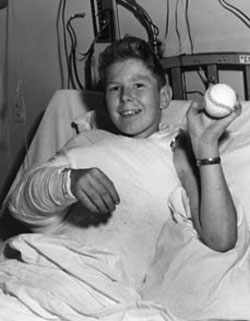
Early Somerville living built character by Paul Maisano
(The opinions and views expressed in the commentaries of The Somerville News belong solely to the authors of those commentaries and do not reflect the views or opinions of The Somerville News, its staff or publishers.)
It was dead silent that July morning as I walked by Glen Park. A weird mist covered the entire field. It was almost scary. In the distance, the fog hid the bottom part of the huge old wooden light posts. Those giant splintery pillars seemed to grow out of the white blanket. My eyes locked on to the top portions set up against the early morning sky. The clusters of silver metal cans that housed massive glass light bulbs once again promising to light the night softball games all summer…were dark.
This was our Fenway Park here in East Somerville, MA.
And we had the best right-handed pitcher in the city. Some people said, “In a few years this kid is destined to play for the Red Sox.” If you stood behind the steel screen at home plate you could watch his pitches dance. Hardly anyone could hit this kid’s stuff. Every Little League coach knew of him, every batter feared the hiss of his fastballs.
This year it was all going to change, and it would never be the same.
I had just finished delivering the Saturday papers for the second week in a row. Somehow I was CONvinced to fill in for my friend while he was away at a camp in New Hampshire. He was one of the lucky ones chosen that year by the Lions Club to receive a three week free scholarship out in wilderness. Avoiding the city summer heat was a gift.
The paper route job was crazy. I had to get up every day for the next three weeks at 4:30 a.m., walk in the darkness to the news office on Broadway, fold 95 papers, then stuff them in a white canvas bag and get them delivered by the 7:00 a.m. deadline.
This was my second Saturday doing this favor. But today I would be grateful for many things. One thing was that the Boston Globe papers were light, and the Record American tabloid was so thin it was not worth the ink. With only two weeks to go, this madness was nearly over. Soon I could sleep in like a normal nine year old kid.
However, as I passed Dell Street something strange happened. I had a flash back of a front-page edition of an earlier Record American we delivered while training for the route.

It was a picture of another neighborhood kid named Everett Knowles. We knew him as “Red.’ It showed him in a near full body cast. It told his story. A front-page story that would change lives, especially Red’s.
This neighborhood kid made headline news all over the world. And so would a thirty-year-old doctor at the Massachusetts General Hospital who graduated from Harvard Medical School at the age of 23.
In order to fully understand this story, you need to be familiar the neighborhood. City kids sometimes do crazy things. I don’t know if it is a result of boredom, stupidity, or just plain insanity. Like many places in New England, we had a Boston & Maine railroad route at the edge of our neighborhood. It was a spot to hang out, and most times a place to get in trouble. The younger kids would pass time by placing small pieces of metal on the tracks to see how flat the freight train wheels would make them. Old spoons were the best. As the train passed over the objects, they flatten like a pancake. Sometimes we would reach in while the train moved allowing only one set of wheels to crush them. That was the crazy part. NO FEAR!
The older kids were a little more daring, or insane. These guys wandered into the B&M railroad supply hut pilfering these small red things with lead straps. They called them ‘dynamite caps’. These guys would put two, or three, of these things in a row on the commuter rail track knowing that the rapid succession of small explosions would signal the so called “bud liner train” to an emergency stop. All the conductors would have to get out and walk around the train looking for a problem. The train conductors did not know that the problem was watching them from a distance. Hiding in the steel of the Cross Street overpass bridge, just out of clear sight, undetected. These kids were nuts. I’m sure the railroad police thought they were a pain in the “tuckus.”
However, they played a much more dangerous game. They hopped onto the moving freight cars at the railroad storage yard as the railroad shuffled the empty freight cars around to make room for the full ones. The game was to jump onto these cars while they rolled into the lower yards. Some kids rode these freight cars to the western part of the city. You could even hop onto a freight train car jump off near Porter Square in Cambridge, or if you were running away from home, just keep going.
Now, for the Everett Knowles part. In late May, of 1962, around mid-afternoon, this freckled faced, twelve year old, was coming home from school. He decided to jump a freight car heading home to the end of Glen Street. He lived only a short walk from there, near Glen Park. While hanging on to the steel ladder rail of the moving freight train car, suddenly something went drastically wrong. As the trained rolled under the Gilman Street bridge structure, he didn’t hug the ladder tight enough. The result was his right arm and shoulder hitting the stone like structure tearing it almost clean off, knocking him to the ground.
The good news was he somehow avoided getting run over by the trains’ wheels as it continued to pass by him. The bad news was he would never pitch for the Red Sox.
In severe shock, Everett staggered a hundred feet to a nearby paper company yard. A worker noticed that Red was holding his arm in the bloody jacket sleeve with his left hand. His right hand appeared to be facing the wrong way. The Somerville Police were called, and they immediately transported him to the Massachusetts General Hospital Boston, a couple miles away.
At first glance, the MGH emergency room doctors thought it was impossible to the save the pitcher’s right arm. But on this day there was a special doctor on duty, Dr. Ronald Malt, a thirty year old chief resident surgeon, who thought differently.
In just minutes, Dr. Malt made a decision to try something that was talked about, but never performed. Instantly, Dr. Malt ordered the arm be placed on ice, and assembled a medical dream team at the famous hospital. The group of medical professionals labored for nearly 15 straight hours performing the first full limb reattachment known to medicine.
With all the potential complications, within a few days, Red’s hand began to regain color. Eventually he was able to move his fingers, and feel pain. Although a number of subsequent operations would be required to reattach nerves, and tendons alike, it was an obvious success.
The world’s first full limb reattachment took place in Boston, MA, on a 100 pound freckle-faced Somerville kid.
Towards the end of the summer I visited Red at his small Dell St. home. My visit was required to be less than an hour. His upper body cast was a masterpiece of plaster art. The hidden work inside of the MGH team of doctors was a miracle. Red was in great spirits. He proudly boasted of all the get well cards he received. There was even a gift from some astronaut, and a couple major league baseball stars.
A couple years later I saw Red at Glen Park. He was tossing baseballs up with this same left arm sent them deep into the outfield with a single motion. His right arm was half the size of the left, but functional. He obviously favored the good arm too much. Even with the therapy, it was going to be a tough road.
A few years later we bumped into each again. He was working at small body shop behind the Mt. Vernon restaurant. Red was repairing cars, now using both hands. I noticed his determination to use his right hand to start bolts, then finalizing the torque effort with a wrench utilizing the power from his left arm.
I haven’t seen Everett “Red” Knowles in years. I heard that he worked at many jobs, driving a delivery truck, hauling sides of beef, and racing cars. Rumor has him living someplace in Eastern Massachusetts on the North Shore. But I know one thing is clear. Wherever Red is he never, never, gives up.
Dr. Malt never gave up either. After performing the surgery on Everett Knowles that day Dr. Malt was propelled into the medical history books. His career not only soared as that of a world-renowned clinical surgeon, but one as an author, researcher, professor, and scientist. Unfortunately, this caring, innovative, brilliant man died in October of 2002. He passed from complications of Alzheimer’s disease at the age of 70. The world lost a great man.
As for me, I never went back to play in the freight yard. I did foolishly once again help out my friend just after Christmas. A blizzard hit on a Saturday night. It took me six hours to drag the sled loaded with papers through the fifteen inches of snow. Both papers were huge. But I never gave up. I delivered all 91 papers. Did I say 91 papers?
I do have a half-century-old secret to share. I buried four Boston Globes at the bottom of Hillside Ave. in the deep snow. It was another good day in Somerville, Massachusetts. This story is true as authored by Paul Maisano.

















Hi, I was 13 when I read of Everett Knowles and followed his magazine in Life magazines I read at a doctors office where I worked on his yard. I was fascinated with the story and success. Always wished I could have shared my feelings with the young man. I eventually went into medicine and know what skills were used to accomplish this feat. Is there any way that I could just write him and respect his privacy. Sincerely, Carl Keene MD
Dr. Keene,
I live next to Eddie and told him you’d like to contact him. Here is his mailing address. He doesn’t have e-mail.
Everett Knowles
493 Washington St Apt D
Wellesley, Ma 02482